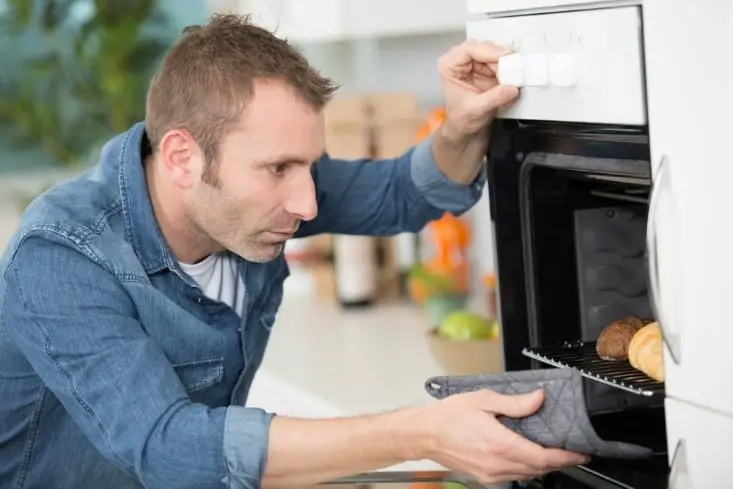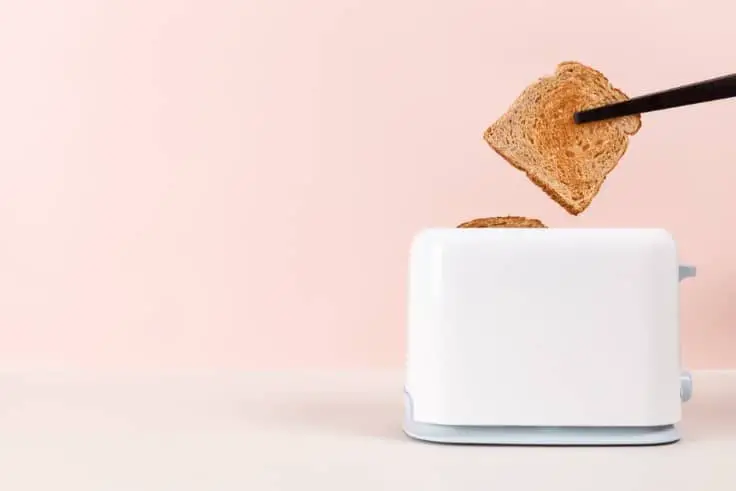Warm bread has better taste, texture, and flavor than cold bread. If you have some leftover bread, you may be wondering how to warm it without making it rock-hard, too crispy, or dry. Depending on the type of kitchen equipment and appliances you have, there are several techniques to warm your bread and retain its texture and taste. We help you find the best way to reheat bread by reviewing the bread you’re using and the results you want.
Below are the best methods for reheating bread and simple steps to follow for each method. We also offer additional tips for reheating bread.
Best Way to Reheat Bread: It Makes a Difference!

1. Oven: Best Way to Reheat Bread by the Loaf
The oven is great for reheating a few slices of bread or the entire loaf. The key is to set the oven at the right temperature—350°F. If you set the temperatures too high, the bread will burn. On the other hand, if you use lower temperatures, the bread will take longer to reheat, causing it to dry out.
Below are the steps for reheating bread in the oven:
- Preheat the oven to 350°F
- Spray a thin layer of water on the bread
- Wrap it with aluminum foil
- Put it in the preheated oven and bake for 10-15 minutes. Bake for 10 minutes if the bread is smaller and 15 minutes for thicker bread or those with a thick, crunchy crust.
- Remove from the oven and serve immediately
2. On the Stovetop
This is yet another easy way to reheat bread. You will need a deep skillet or cooking pot with a lid and aluminum foil. Below are the steps to follow:
- Wrap the bread in aluminum foil
- Place it in the skillet or cooking pot and cover it with the lid
- Place the skillet or cooking pot over the stove on low to medium heat
- Cook for 5-10 minutes until the bread is reheated adequately. You may check after the first couple of minutes. If it is warm enough, remove it from the stove and serve. If not, continue to reheat for another 5 minutes
3. Using a Steamer Pan
A steamer pan is a great way to reheat dry and hard bread. However, this method does not revive the crispiness of the bread. Below are the steps for reheating bread using a steamer pan.
- Put water in a steamer pan and place it over a stove top to simmer
- Wrap the bread in aluminum foil. Ensure that the whole bread is fully and securely covered to prevent steam from getting in and making it soggy
- Place the bread on the steaming tray over the simmering water
- Let it steam for 10-15 minutes
- Remove the bread from the steamer pan, unwrap it, and serve
4. Using a Toaster: Best Way to Reheat Bread If You Want it Crispy
If you want to reheat your bread fast and achieve a crispy texture, use a toaster or a toaster oven. This method works best for slices of bread. Therefore, if you need to reheat the whole bread, slice it into pieces that fit your toaster. Below are the steps for reheating bread in a toaster.
- Slice the bread into portions that fit into your toaster
- You may or may not butter the bread, depending on your preference
- Load the slices of bread into the toaster slots
- Set the toasting level or temperature
- Push down the toaster knob to lower the slices of bread into the toaster
- Once the toasting cycle is complete, the toaster knob will reset—come up—pushing the slices of bread up for retrieval
- Use tongs to remove the reheated slices of bread. Do not touch them immediately after they pop up, as they may be too hot
- If you have other slices of bread remaining for reheating, repeat steps 3-7
5. Using the Microwave
Using the microwave is not a preferable method for reheating bread. Its heating mechanism tends to leave bread dry, hard, and chewy. However, there are measures you can take to be able to reheat bread in the microwave without making it hard and dry. Below are the steps for heating bread in a microwave for the best results.
- Put 3-5 tablespoons of water in a small microwave-safe bowl
- Put the bowl in the microwave and heat the water for 1 minute on high power settings. The heated water builds up steam in the microwave, making it moist to prevent the bread from drying.
- Lay two paper towels on a microwave-safe dish that can fit your loaf or slices of bread. Place your bread on the dish
- Cover the bread loosely with a damp paper towel
- Put it in the microwave
- Heat on low heat for 10-15 seconds
- Remove the bread from the microwave, turn it, and cover it with a damp paper towel
- Put it back in the microwave and heat for 10-15 seconds.
- Remove the bread from the microwave and serve immediately.
6. Using an Air Fryer
Another simple way to reheat bread is using an air fryer. Here are the steps to follow:
- Lay a baking sheet on the air fryer basket
- Preheat the air fryer
- Spray a thin layer of olive oil on the baking sheet
- Put the bread in the air fryer basket
- Let it cook for a couple of minutes
- Serve
Tips for Reheating Bread

If You Have Frozen Bread, Ensure It Thaws Completely Before Reheating It
One of the best ways to preserve leftover bread is to freeze it. Wrap it snugly with plastic wrap or stash it in the freezer in the paper bag it comes in for up to three weeks. If you intend to freeze it for longer, reinforce the seal by covering it with an additional layer of plastic bag to keep air out.
If you will eat the bread the next day, remove it from the freezer and let it sit in the refrigerator for 12-24 hours to defrost. Remove it from the refrigerator about an hour before reheating and let it acclimate to room temperature. Then reheat using your most preferred method, as discussed above.
Use Water
When reheating bread, water ensures that the bread does not become hard and dry. There are various ways to incorporate it into the reheating process. You may sprinkle or spray water over the entire bread or the slice you are warming.
Alternatively, place a bowl of water inside the heating appliance, e.g., at the bottom of the oven or inside the microwave. The water releases steam, which moisturizes the bread when reheating.
Reheat at Low Temperatures
Heating at a high temperature is most appropriate if you want to crisp the bread, e.g., when toasting it. If you simply want to warm without crisping or browning the bread, cook at low temperatures for a little longer. It allows time for the entire slice or loaf of bread to warm evenly without burning. Use low to medium heat settings—300°-325°F.
Do Not Heat for Too Long

Even though heating at lower temperatures requires that you cook for longer, you do not want to overcook the bread. In most cases, 5-10 minutes are enough. When using a stove or microwave, it may take shorter. Therefore, keep a close eye on the bread to prevent it from cooking too long.
Wrap the Bread When Warming It
This tip is most applicable when reheating the bread in the oven. Wrap the whole bread with aluminum foil before putting it in the oven. The foil traps moisture ensuring the bread remains soft. If using a microwave, you can wrap the bread with a damp paper towel.
Reheat the Entire Loaf Instead of Slice
Unless you have a few slices of bread left or use a toaster, reheat the entire loaf for the best results. Slices are thinner and more prone to burning or drying out if you do not carefully control the reheating time and temperatures.
Serve the Bread Immediately After Reheating
Once you have reheated the bread, serve it immediately. Do not wait for it to cool again; you will have to reheat it a second time. Reheating the bread more than once will result in it drying out and a less-than-optimal taste and texture.
As such, if you anticipate that you will not consume the entire reheated bread, divide the bread into different portions and only reheat the portion you will eat immediately after warming.
Best Way to Reheat Bread: SOLVED!
If you have leftover bread that is not yet stale, there are several simple ways to reheat it to revive its flavor, taste, and texture. While some methods, such as using the oven, are most suitable for reheating the entire loaf of bread, others, such as using a toaster, are great for slices of bread.
Others can be used for both slices and a loaf of bread. Note that you should not reheat stale bread as doing so does not revive its freshness. Rather it makes it harder, drier, and chewy.
